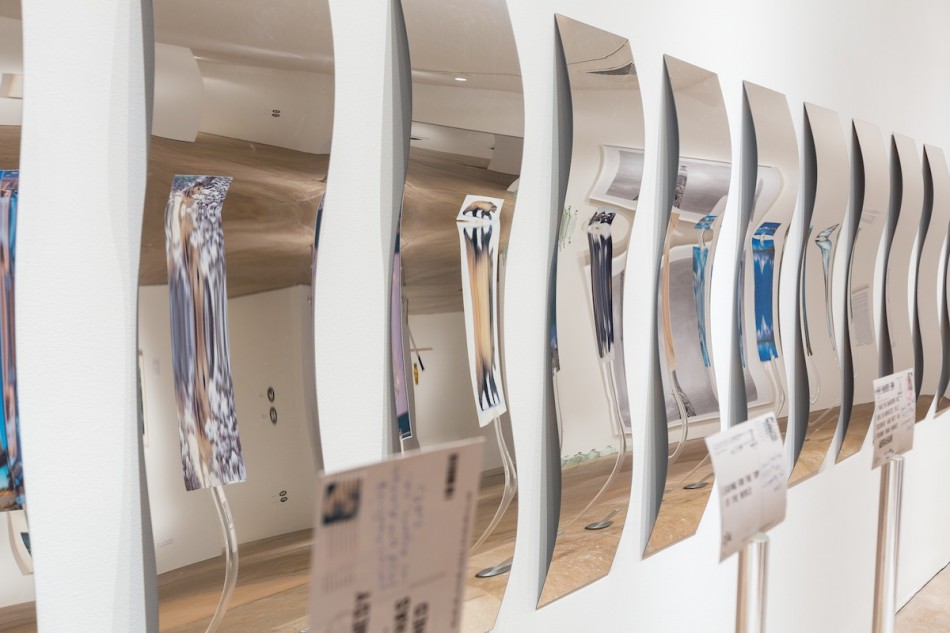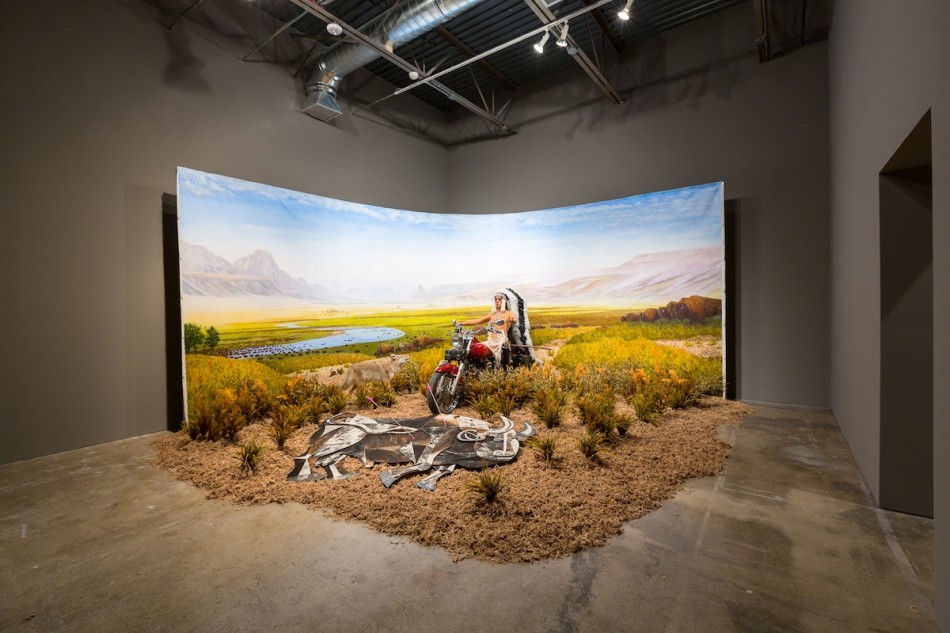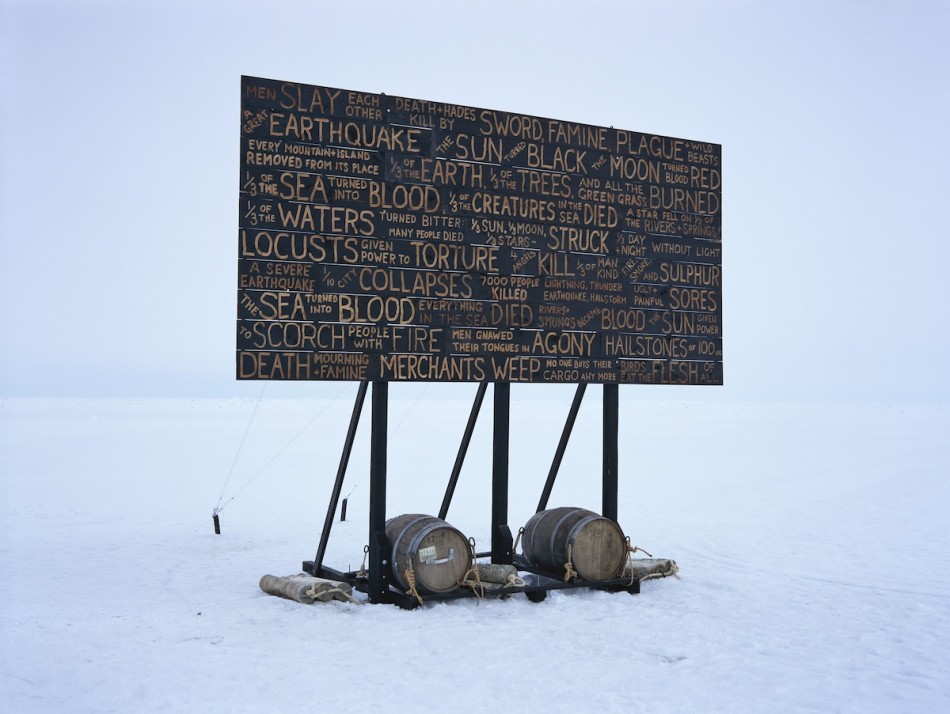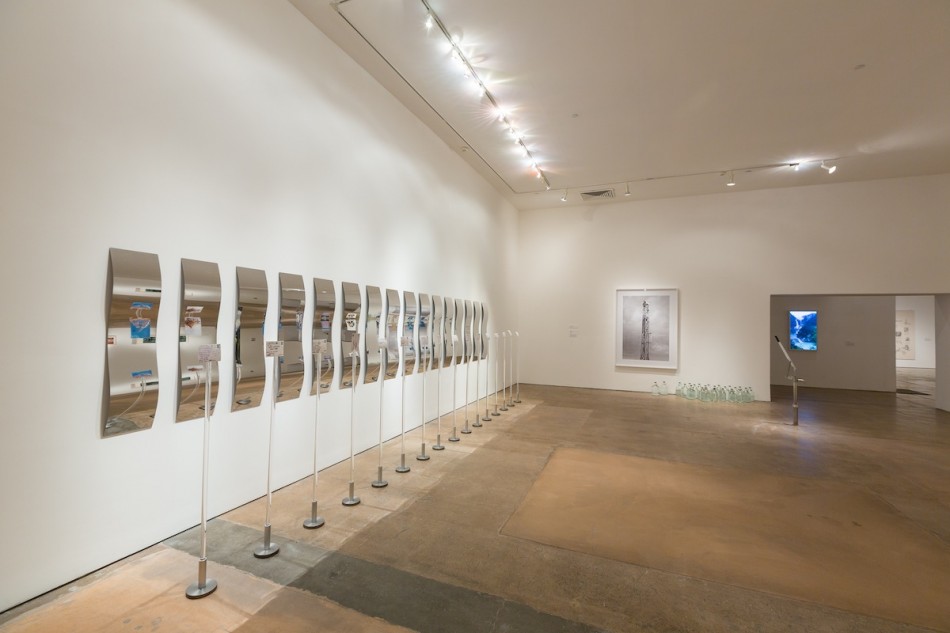
Daniel Joseph Martinez; Installation view of "She could See Russia from Her House, Those who wish for peace should prepare for war! —Old Sasquatch Proverb (In search of the Tribe Called Sasquatch, or who really built the Alaskan Oil Pipeline); 16 Communiqués and found photographs from traveling the length and breadth of Alaska during the month of August, 2009,” 2010; 16 postcards, mirrors and Plexi rods; 6.5 x 30 x 5 feet; Courtesy of the artist
Unsettling, Unsettled Landscapes: SITElines in Review
One of the ways a culture responds to unsettled landscapes is to create architectural space. SITE Santa Fe’s new biennial, “SITElines: New Perspectives on Art in the Americas,” announces Santa Fe as a locus where multiple cultures and histories touch. The first edition of this three-part biennial sees the museum reaching for new contemporary work along a site line stretching from Nunavut in far northern Canada to Tierra del Fuego at the southern tip of Argentina. The genius and geography of place is at its center; 45 artists or artist’ collectives participate.
A Sign
Vancouver artist Kevin Schmidt once attached a homemade camera to a small weather balloon to record the curving world for later projection alongside Caspar David Friedrich’s “Wanderer Above the Mist.” He never did get a good picture. As Canadian Art observes, Schmidt is attracted to “the humorous, and often absurd, struggle for agency” — the performative gesture made precarious against the adversarial sublime of the natural world.
In the case of “A Sign in the Northwest Passage,” Schmidt hand-routed fragments from the biblical Book of Revelation onto a large piece of cedar. The idea was that the sign would float free with the late spring melt, bobbing on two homely barrels, warning of disasters such as those from oil and natural-gas extraction. To watch the accompanying video is to be struck by the loneliness of the object, the predicament of this billboard drifting away in the thaw. Much of the work’s impact lies in its physical insignificance — indeed in its disappearance, as we follow Schmidt’s efforts in early summer to locate it by plane over the greening archipelagos. With only the documentation of the work remaining, it invites reverie, as of the ark bringing messages of rising sea levels to polar bear and gull.
In the Looking Glass
Conceptual artist Daniel Joseph Martinez rode Los Angeles buses for three years, imagining riders’ inner lives, “trying to insert poetry into the streets . . . to rupture how we see signage.” He then traveled the length of the Trans-Alaska Pipeline, periodically sending postcards inscribed with “odd” and “apocalyptic” utterances to friends in L.A. Mounted on plexiglass poles at eye level, each postcard faces its own mirror of irregular contours, which disfigure the images — and the viewers.
With reference to the funhouse sightline of Sarah Palin, Martinez elides a personal and surrealistic Alaska, its unsettled and unsettling Nature, the unnerving presence of pipeline and wilderness in “She could see Russia from her house! Those who wish for peace should prepare for war! —Old Sasquatch Proverb (In search of the Tribe Called Sasquatch, or who really built the Alaskan Oil Pipeline) 16 Communiqués and found photographs from traveling the length and breadth of Alaska during the month of August, 2009.” His communiqués (“I found white Alice,” “In glory undimmed before the breaking of the world”) overlie the postcards’ more prosaic texts to induce a double vision of free-market tourism and Martinez’ conceptual subjectivity.
That the reflections continuously shift according to our own movements can produce awkwardness about how to “be” in front of an art object. Martinez hands us a performative role: a few steps backward sends the images into protean abstraction and, contextualized within the larger exhibition, uncanny beauty. Because the mirrors are configured for the purpose, polar bears or Alaskan highways stretch and contract into Rorschach images — an apt psychological test as we encounter our bodies upside down and right side up, the grotesque proportions a stand-in for that which we usually recognize as ourselves.
Pink Arrows
Wearing a cascading headdress and painted lips, her legs clad in dominatrix leather boots and straddling a scarlet motorcycle, Kent Monkman’s “Miss Chief Eagle Testickle” rides her unsettled gender into the middle of a museum diorama. Against the backdrop of grazing buffalo and mountains painted in the style of Albert Bierstadt’s “Last of the Buffalo,” she not only routs stale depictions of Plains warriors; her seditious glamour confronts the mannequined representations in natural history museums of First Nations peoples fixed by the largely white curatorial gaze of Western conquest. Monkman has long been taking down Picasso’s masculine modernity, and the bull of his “Guernica” lies pierced with pink arrows. One of the artist’s chief aims has been to expose the appropriation of “primitive art,” with paintings set in a 19th-century West or in the streets of the “rez” being strewn with injured cubist figures.
Gay and of Irish and Cree descent, Monkman adopted Miss Chief as an alter ego, performing her in full burlesque. As a historical revisionist he has had his eye on the cultural homophobia of 19th-century artist George Catlin, who in his painting “Dance to the Berdache” portrayed the Mandan ceremonial dance of the “two spirit” native peoples, often revered, who take on the attributes and dress of the opposite sex. Catlin assumed he was capturing a “vanishing world” but, through Miss Chief, Monkman positions himself as rival to Catlin and creates as well a contemporary incarnation of the berdache. Catlin characterized the berdache ceremonial as “one of the most disgusting things” he’d ever encountered. “I should wish,” he continued, “that it be extinguished before it be more fully recorded.” More pink arrows.

Kent Monkman Bête Noir (detail), 2014; Installation view; Acrylic on canvas with sculptural installation; Courtesy of the artist and Sargent’s Daughters, New York; Photo: Eric Swanson

Kevin Schmidt; A Sign the Northwest Passage, 2010; LightJet print, cedar framed; 64 1/4 x 49 inches; Courtesy of the artist and Catronia Jeffries Gallery, Vancouver

Daniel Joseph Martinez; Installation view of “She could See Russia from Her House, Those who wish for peace should prepare for war! —Old Sasquatch Proverb (In search of the Tribe Called Sasquatch, or who really built the Alaskan Oil Pipeline) 16 Communiqués and found photographs from traveling the length and breadth of Alaska during the month of August, 2009,” 2010; 16 postcards, mirrors and Plexi rods; 6.5 x 30 x 5 feet; Courtesy of the artist
